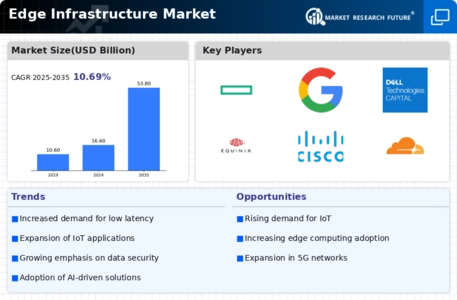Expansion of 5G Networks
The ongoing expansion of 5G networks is significantly influencing the Edge Infrastructure Market. With the rollout of 5G technology, the capacity for data transmission increases exponentially, enabling faster and more reliable connections. This advancement facilitates the deployment of edge computing solutions, as it allows for the processing of vast amounts of data at the edge of the network. Analysts predict that by 2025, 5G subscriptions could surpass 1.5 billion, further driving the need for robust edge infrastructure. The integration of 5G with edge computing not only enhances mobile broadband experiences but also supports the proliferation of IoT devices, which are expected to reach over 30 billion by 2030. This synergy between 5G and edge infrastructure is likely to reshape various sectors, including healthcare, transportation, and smart cities.
Emergence of Industry 4.0
The advent of Industry 4.0 is significantly shaping the Edge Infrastructure Market. As manufacturing processes become increasingly automated and interconnected, the need for real-time data processing at the edge becomes essential. This transformation is driven by the integration of IoT devices, AI, and machine learning technologies, which collectively enhance operational efficiency and decision-making. Reports suggest that the global market for Industry 4.0 technologies could reach 300 billion USD by 2025, underscoring the critical role of edge infrastructure in this evolution. By facilitating immediate data analysis and response, edge computing enables manufacturers to optimize production lines, reduce downtime, and improve product quality. Consequently, the Edge Infrastructure Market is poised for substantial growth as industries embrace this new paradigm.
Growth of Smart Cities Initiatives
The development of smart cities is a pivotal driver for the Edge Infrastructure Market. As urban areas increasingly adopt smart technologies, the demand for efficient data processing and management solutions escalates. Edge computing plays a crucial role in enabling real-time analytics for various applications, including traffic management, energy distribution, and public safety. According to recent studies, investments in smart city projects are expected to exceed 2 trillion USD by 2025, highlighting the substantial market potential for edge infrastructure. This growth is likely to foster collaborations between technology providers and municipal governments, aiming to create sustainable urban environments. The integration of edge solutions within smart city frameworks not only enhances operational efficiency but also improves the quality of life for residents, making it a key area of focus for future development.
Rising Demand for Low Latency Applications
The Edge Infrastructure Market is experiencing a notable surge in demand for low latency applications. As businesses increasingly rely on real-time data processing, the need for edge computing solutions becomes paramount. Industries such as finance, gaming, and autonomous vehicles are particularly sensitive to latency, necessitating infrastructure that can deliver data with minimal delay. According to recent estimates, the edge computing market is projected to reach a valuation of approximately 15 billion USD by 2026, driven by this demand. This trend indicates a shift towards decentralized computing, where data is processed closer to the source, thereby enhancing performance and user experience. Consequently, organizations are investing in edge infrastructure to meet these evolving requirements, positioning themselves competitively in their respective markets.
Increased Focus on Data Privacy and Compliance
As data privacy regulations become more stringent, the Edge Infrastructure Market is witnessing a heightened focus on compliance and security measures. Organizations are compelled to adopt edge computing solutions that not only enhance performance but also ensure data protection. The implementation of regulations such as GDPR and CCPA has led businesses to rethink their data management strategies, often opting for localized data processing to mitigate risks associated with data breaches. This shift is expected to drive investments in edge infrastructure, as companies seek to establish secure environments for sensitive information. Furthermore, the market for edge security solutions is anticipated to grow, with projections indicating a compound annual growth rate of over 20% through 2027. This trend underscores the critical importance of integrating security into the edge infrastructure framework.

















Leave a Comment